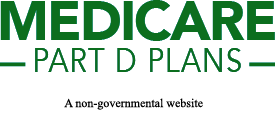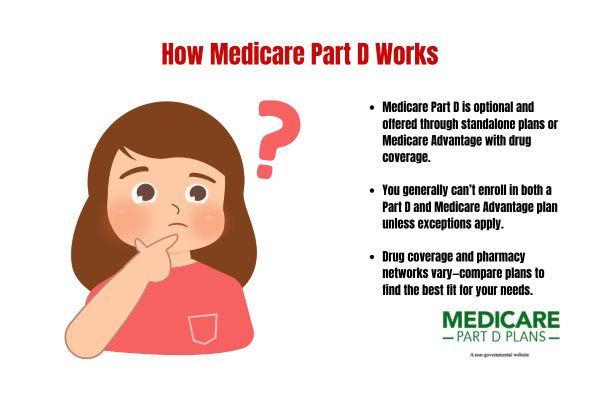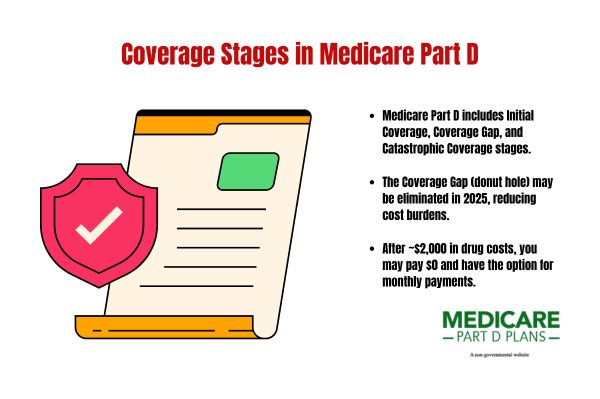Find a Medicare Part D prescription drug plan

Medicare Part D
Prescription Drug Coverage 2026
Do I Need Medicare Part D?
Do I need Medicare Part D? If you rely on prescription medications, Medicare Part D could help cover the costs not included in Original Medicare. This article will explain what Medicare Part D is and why it might be important for you.
Key Takeaways
- Medicare Part D will likely provide essential prescription drug coverage for individuals with Original Medicare, potentially protecting them from high out-of-pocket medication costs.
- Beneficiaries may choose between standalone Part D plans or Medicare Advantage plans that might include drug coverage, likely making it important to compare options based on drug formularies and costs.
- Possible costs of Medicare Part D might include monthly premiums, an annual deductible of about $590, and varying copayments, with an approximate $2,000 cap on out-of-pocket costs for prescription drugs.
Understanding Medicare Part D
Medicare Part D is a form of Medicare Part D prescription drug insurance that will likely be designed to assist beneficiaries with outpatient prescription drug costs.
It may be primarily intended for those with Original Medicare (Part A and/or Medicare Part B) who want to cover prescription medications, as Original Medicare does not cover most prescription drugs. This means that without Part D, some individuals might face high out-of-pocket costs for their medications.
Although enrollment in Medicare Part D may be optional for those with Original Medicare, it could be highly beneficial. Individuals may opt to pay for a stand-alone Part D plan to receive drug coverage, potentially ensuring they could be protected from high prescription drug costs.
To qualify for Medicare Part D coverage, individuals must have Original Medicare, which includes Parts A and B. This requirement will likely be necessary to obtain the benefits.
Medicare Part D plans should cover certain categories of drugs, which may help ensure that beneficiaries have access to a broad range of medications, both brand-name and generic drugs. The variety and flexibility of these plans will likely enable Medicare beneficiaries to find a plan that best suits their health needs and budget.
The Importance of Prescription Drug Coverage
Having prescription drug coverage may be essential for managing healthcare costs, especially since Original Medicare does not cover most prescription drugs. Medicare Part D could be crucial for managing costs associated with both brand-name and generic medications.
Even if you do not use many medications now, maintaining Medicare Part D coverage will likely be important because health needs may change over time, potentially leading to the need for more prescriptions.
Medicare drug coverage will likely be provided by private insurance companies approved by Medicare. While Medicare Part D plans may be somewhat standardized, significant differences might exist between plans offered by different insurers, so it’s important to carefully compare options to get the best coverage for your needs.
How Medicare Part D Works
Medicare Part D is optional and available to Medicare recipients through private insurance providers authorized by Medicare. Beneficiaries could either enroll in a standalone Part D plan or choose Medicare Advantage plans that include drug coverage. It’s important to note that generally, you cannot buy a separate Medicare Part D plan if you already have a Medicare Advantage plan, with some exceptions.
Medicare drug plans will likely decide which medications and pharmacies may be included in their coverage. Understanding your plan’s pharmacy network could help you access lower costs and convenience.
Specific drug coverage and pharmacy networks may vary significantly by Medicare Advantage plan, so thorough research may be necessary to find the best fit for your needs.
Ultimately, prescription drug coverage may be obtained either through a Medicare Advantage plan or standalone Medicare coverage. This flexibility will likely allow beneficiaries to choose the plan that best meets their individual health needs and financial situation.
Potential Costs Associated with Medicare Part D
Knowing the possible costs associated with Medicare Part D may be essential for budgeting and managing your healthcare expenses. Common cost components might include:
- Monthly premiums that may vary across different insurers.
- An additional monthly surcharge for higher-income individuals.
- A maximum deductible set by law, which may be set around $590
Copayments and coinsurance rates for Medicare Part D may also vary based on prices negotiated by each plan with drug manufacturers and pharmacies, as well as Medicare guidelines. The cap on out-of-pocket costs for Part D prescription drugs might be set around $2,000, possibly offering significant financial protection for beneficiaries.
Monthly Premiums
Monthly premiums for standalone Medicare Part D plans may include various costs such as annual deductibles, copays, and coinsurance. The average monthly premium for Medicare Part D plans may be set around $46.50. Your specific plan will likely affect your monthly premium, as different plans might have different structures and benefits.
High-income beneficiaries might pay an additional amount of around $13.70 to $85.80 on top of their monthly premiums. Consider these additional costs when selecting a plan, as they could significantly impact your overall healthcare budget.
Annual Deductibles
The deductible for Medicare Part D plans cannot exceed around $590. The annual deductible for CY
Meeting the annual deductible will likely be crucial for beneficiaries as it could impact overall out-of-pocket expenses throughout the year. Understanding and planning for this cost could help you manage your healthcare expenses more effectively.
Copayments and Coinsurance
Copayment amounts for drugs may vary based on negotiations between each plan and pharmacies. The maximum cost for a 1-month supply of covered insulin drugs through Part D may be set around $35. Individuals with high out-of-pocket medication costs who do not qualify for Extra Help could potentially benefit from the Medicare Part D cap.
The Part D cap will likely be automatic for participants. The only eligibility requirement will likely be participation in a Medicare Part D plan. This cap could offer significant financial relief for those with extensive medication needs.
Coverage Stages in Medicare Part D
Medicare Part D consists of three coverage stages:
- Initial Coverage
- Coverage Gap
- Catastrophic Coverage
The Coverage Gap, known as the donut hole, might be eliminated in 2025, possibly simplifying Medicare Part D coverage. This potential change could remove a significant burden for many beneficiaries who previously faced higher costs during this phase.
In the Catastrophic Coverage stage, beneficiaries might not need to pay anything for covered medications after reaching about $2,000 in total drug costs. Members may also have the option to spread out-of-pocket costs into monthly payments, possibly providing further financial flexibility and relief.
Enrollment Periods for Medicare Part D
The Initial Enrollment Period is a seven-month timeframe that begins three months before a person turns 65 and includes the birthday month. If a person’s birthday falls on the first day of the month, their Initial Enrollment Period starts four months before and extends to two months after their birthday month.
Individuals can change their Medicare Part D plan during the open enrollment period, lasting from October 15 to December 7 each year. During this time, beneficiaries can switch plans or enroll in a new one as their health needs change.
A Special Enrollment Period allows individuals to enroll in Medicare Part D outside the regular enrollment periods, typically lasting two months. Qualification for this period can occur when losing current coverage, such as creditable prescription drug coverage from an employer.
See plans in your area instantly!
Advertisement
Avoiding Late Enrollment Penalties
Enrolling in Medicare drug coverage, even if you currently do not need medication, could help you avoid late enrollment penalties. If you lack creditable prescription drug coverage for 63 consecutive days or more, be prepared to incur a late enrollment penalty for Medicare Part D.
The average premium for Medicare Part D will likely determine the penalty amount if you enroll late. Enrolling during your Initial Enrollment Period (IEP) allows you to avoid late enrollment penalties. Continuous coverage will likely be key to avoiding additional costs.
Comparing Medicare Part D Plans
When comparing Medicare Part D plans, members should verify the following:
- Whether your medications may be included in the plan’s formulary.
- If the plan requires prior approval for certain drugs.
- Whether there are any limits on drug amounts per copay.
- If the plan mandates lower-cost alternatives.
Ensuring your current and potentially needed covered prescription drugs in health care might be covered could help you save money, possibly prevent unexpected expenses, and help ensure you receive necessary medications.
Check the pharmacy network when selecting a Medicare Part D plan to find the lowest costs and ensure convenience. Different plans may have different pharmacy networks, affecting where you fill your prescriptions and at what cost.
Additional Assistance Programs
The Extra Help program could assist limited income individuals with some out-of-pocket Medicare Part D costs. Eligibility will likely be determined based on income and resources. This program may help cover costs associated with prescription drugs, such as deductibles and copayments.
Individuals may apply for the Extra Help program at any point, regardless of their enrollment status in Part D.
The Potential Impact of Legislation on Medicare Part D
The Inflation Reduction Act could help support individuals with Medicare coverage, possibly bringing significant changes to Part D. The Final CY
Part D sponsors may receive a government subsidy for selected drugs equal to about 10% of the drug’s negotiated price. The Medicare Prescription Payment Plan may also be available, possibly offering new payment options.
The Medicare Part D cap will likely be set at around $2,000, but may exclude plan premiums, uncovered drugs, and out-of-pocket spending on Part B drugs.
Find a Plan and Enroll Online Yourself!
Advertisement
Summary
Navigating Medicare Part D might seem overwhelming, but understanding its components could significantly impact your healthcare experience. From understanding the importance of prescription drug coverage to learning about the various costs and coverage stages, being informed allows you to make the best decisions for your health and finances.
We hope this article has provided clarity on Medicare Part D and its significance. Remember, staying informed and proactive in managing your Medicare Part D coverage could lead to better health outcomes and financial security. Take charge of your healthcare, and ensure you are making the most of your Medicare benefits.
Frequently Asked Questions
What is the maximum deductible for Medicare Part D?
The maximum deductible for Medicare Part D may be set at $590. This amount will likely be set by law to help manage prescription drug costs for beneficiaries.
How can I avoid late enrollment penalties for Medicare Part D?
To avoid late enrollment penalties for Medicare Part D, enroll during your Initial Enrollment Period and maintain continuous coverage thereafter. This proactive approach could help ensure you won’t face additional costs.
What is the average monthly premium for Medicare Part D plans?
The average monthly premium for Medicare Part D plans may be set at $46.50. This information could be crucial for budgeting healthcare expenses effectively.
What assistance programs may be available for low-income individuals with Medicare Part D?
The Extra Help program will likely be available to aid low-income individuals with out-of-pocket costs for Medicare Part D, possibly covering expenses such as deductibles and copayments. Additionally, state programs may provide further assistance tailored to specific needs.
What are the coverage stages in Medicare Part D?
The coverage stages in Medicare Part D are Initial Coverage, Coverage Gap (often referred to as the donut hole), and Catastrophic Coverage. Understanding these stages will likely be essential for effectively managing your prescription drug costs.
Begin Choosing your plan
Advertisement
ZRN Health & Financial Services, LLC, a Texas limited liability company.



